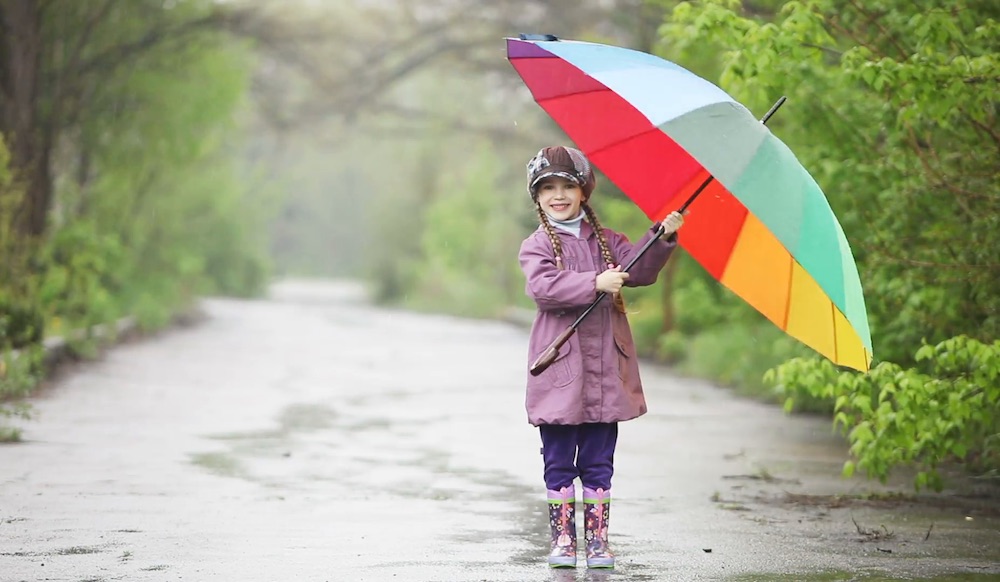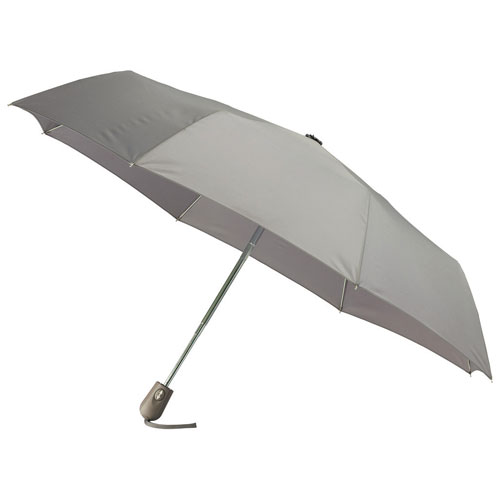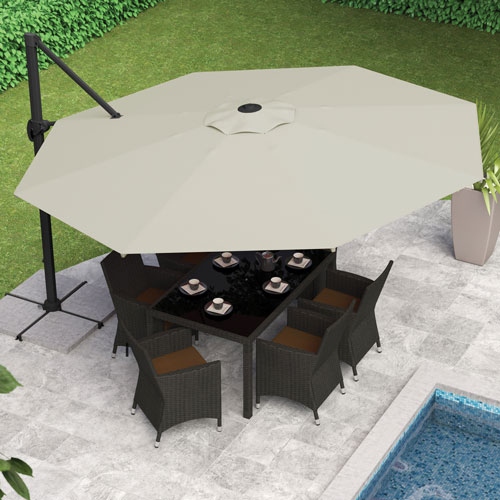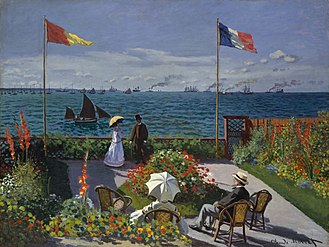
When you think about overlooked household items, what comes to mind? Hair traps, bath mats, cookie cutters… Or maybe just that pair of floppy old umbrellas that you leave by the front door. You know the ones: you’ve had them for so long you can’t remember buying them. The history of umbrellas seems to disappear—and you always seem to forget them when it’s raining.
The umbrella has a much more interesting history than we give it credit for, and it doesn’t deserve to be relegated to the front closet! A great umbrella protects you from the rain and the sun, and it completes an equally-great outfit.
The history of umbrellas
Umbrellas, when they began popping up (pun intended) across Egypt and China, were originally a sign of wealth. And not just a little bit of wealth—we’re talking nobility. The homes of emperors, kings, and queens were the first places where umbrellas were found.
The first personal object used to shield oneself from the sun was likely a palm leaf, held (of course) by a servant. It protected a ruler from the sun while sitting in their throne, or consulting with their advisors. Repurposed items like these go back as far as three thousand years, when Egyptian pharaohs and upper classes used parasols to shield themselves from the sun. Skintone has a rich history of being deeply interwoven with wealth and social class, and by keeping themselves fair-skinned, many cultures used umbrellas to show off their social status.
Egyptian parasols weren’t waterproof, however. Umbrellas for protecting oneself from precipitation weren’t seen until the 11th century BC, in China. That’s when royalty and nobility began using expensive leather umbrellas to keep themselves dry.
These umbrellas later made their way through the trade routes to Europe, where umbrellas enjoyed a brief stead in high fashion until the Roman empire fell . But following the emergence of the Renaissance, umbrellas started popping up again in Italy, France, and England. These “sun shields” (from para, shield, and sol, sun) and “little shadows” (from the Latin umbra, for shadow, and the French -elle suffix, for little) took the fashion world by storm.
. But following the emergence of the Renaissance, umbrellas started popping up again in Italy, France, and England. These “sun shields” (from para, shield, and sol, sun) and “little shadows” (from the Latin umbra, for shadow, and the French -elle suffix, for little) took the fashion world by storm.
The modern umbrella looks quite different from those of days gone by. Today’s umbrellas typically feature handles of metal and plastic, with arches of water-repellant polyester. (Gone are the days of the cured leather umbrella!) But modern parasols look quite similar to historical ones, often featuring lace or paper tops above wooden handles.
The folding umbrella
Folding (or “pocket”) umbrellas were first documented in the Western world in 1928, when they were created by Hans Haupt. But it wasn’t until a few years later, in 1969, that the first folding umbrella was patented. The patent was signed by Bradford E. Phillips, and notes a little quirk of history: it was given out for the first “working folding umbrella” (emphasis mine).
Long before Haupt came up with his concept, the first folding umbrella was actually seen in the late Song Dynasty, China, with documentation in books dating back to 1270 AD. Remarkably little has changed in the shape of the umbrella since then, but little tweaks have improved their use with time. Umbrellas are now available in reversible format (typically with one colourful side and one solid black side), and come in both full-sized folding and travel folding sizes.
A history of umbrellas — and their patents
National Umbrella Day is held on February 10th each year, but at the US Patent Office, Umbrella Day is every day.
So many people are coming up with umbrella ideas in the States that the Patent Office has to employ four full-time examiners just to assess umbrella-related patents. As of 2008, the office apparently registered 3000 active umbrella-related patents, and with each year, that number continues to grow.
The US umbrella situation has gotten to the point where Totes, North America’s largest umbrella producer, has had to altogether stop accepting unsolicited umbrella proposals—and their Director of Umbrella Development (which, yes, is a real title) has had to go on record saying that “it’s difficult to come up with an umbrella idea that hasn’t already been done.”
One of the big changes in umbrellas throughout history is that, today, we feature umbrellas in all sorts of products. They’re an essential part of a baby stroller, and complete any sunny patio set.
I particularly love patio umbrellas that stabilize from the side, with an arm reaching to the top of the umbrella: unlike most centre-stabilized umbrellas, these allow you to easily adjust the height and direction of your coverage. They add a lot of versatility to the umbrella, and are especially great for countries like Canada, where you’re further from the equator. Our long, slow sunsets are greatly improved by being able to block that sun out of your eyes at 7 PM!
Media representations of umbrellas
Umbrellas have a sordid history both in film and other artistic mediums. They’ve been making the rounds for thousands of years throughout history, and not just in the pages of ancient Chinese books!
In the Middle East, parasols often appear in sculptures found around the city of Nineveh, shading representations of royalty. In Japan, women in traditional kimonos are seen on film with their disc-like, oil-paper umbrellas. And in Europe, umbrellas are documented being held by servants above the heads of the aristocracy—or in the delicate hands of young women by the seaside, as in Monet’s Garden at Sainte-Adresse.
 I remember growing up on classic Batman, and seeing Penguin’s tricked-out umbrella in the 1992 Batman Returns. It hid everything from radio transmitters to knife blades and explosives in it—but my lessons in the magic of umbrellas didn’t end there. The parrot-head umbrella carried by Mary Poppins lifted her dreamily down from the skies as she enters in Mary Poppins, an the iconic umbrella is maintained for Mary Poppins Returns.
I remember growing up on classic Batman, and seeing Penguin’s tricked-out umbrella in the 1992 Batman Returns. It hid everything from radio transmitters to knife blades and explosives in it—but my lessons in the magic of umbrellas didn’t end there. The parrot-head umbrella carried by Mary Poppins lifted her dreamily down from the skies as she enters in Mary Poppins, an the iconic umbrella is maintained for Mary Poppins Returns.
But the most iconic umbrella moment of all time is undoubtedly from Singing in the Rain (1952). My grandmother used to sing along with Gene Kelly on what seemed to be a monthly basis, sweeping me off my feet as he danced up and down the rain-soaked set with his umbrella.
What to look for in an umbrella
When purchasing your modern-day umbrella, take a few cues from our ancestors. Look for something waterproof and collapsible, with good structure. I prefer travel umbrellas, which tend to be a little lighter, but you definitely sacrifice sturdiness in exchange for size. If you live in a windy city, choose something durable. Opt for a single fold; i.e. tines that fold inwards to the stem of the umbrella without folding in upon themselves.
As the US Patent Office surely knows, the modern umbrella comes with plenty of bells and whistles. If you want to take advantage of them, consider a walk-safe type umbrella, with reflectors or LED lights. Visibility decreases when it’s rainy out, so a little extra light can’t hurt!
Discover umbrellas online at Best Buy.



